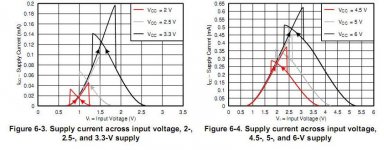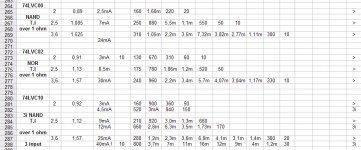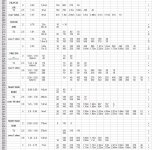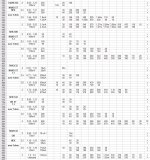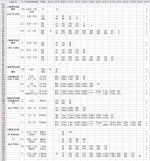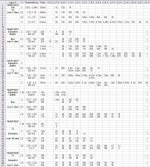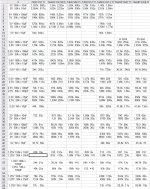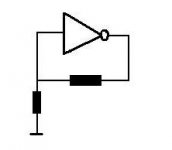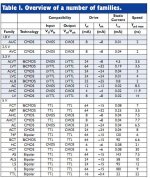You don't want the longer version ? I'm going to give it anyway. 
A word about the tests : I've spent too much time on it , for myself, not really to post here. I've put them in a datasheet so I can copy & paste to compare better than just on paper.
Of course T.I and Nexperia datasheets give some graph's , again of some typical measurements , but I needed to see the real life numbers.
Logic has wide tolerances and even 2 gates on the same chip are slightly different , so look at these datasheets more to compare than the exact values. Adjusting voltages with a small Bourns cermet trimmer , isn't very accurate, so there are small differences in measurements too , although I tested all the same way. Even if it was posible to get it right down to the mV's , it would cost so much more time , and there is only so much time left until we get depopped.
When measuring , you have expectations what it will be , doubling the freq , should double the current draw, but this is not always exactly true , so if you see anomalies, I've seen them too and re-tested . Like : How is it possible that a 2 input gate draws the same (or sometimes less !) current with a high freq on the 2 input vs 1 with HCS? I don't have a clue.
Although I only wanted to compare HCS vs HC , I could buy these LVC's in tssop, cheap and it got me interested in others like AHC and AUP.
These graphs from 74HCS14 datasheet are pretty close.
A word about the tests : I've spent too much time on it , for myself, not really to post here. I've put them in a datasheet so I can copy & paste to compare better than just on paper.
Of course T.I and Nexperia datasheets give some graph's , again of some typical measurements , but I needed to see the real life numbers.
Logic has wide tolerances and even 2 gates on the same chip are slightly different , so look at these datasheets more to compare than the exact values. Adjusting voltages with a small Bourns cermet trimmer , isn't very accurate, so there are small differences in measurements too , although I tested all the same way. Even if it was posible to get it right down to the mV's , it would cost so much more time , and there is only so much time left until we get depopped.
When measuring , you have expectations what it will be , doubling the freq , should double the current draw, but this is not always exactly true , so if you see anomalies, I've seen them too and re-tested . Like : How is it possible that a 2 input gate draws the same (or sometimes less !) current with a high freq on the 2 input vs 1 with HCS? I don't have a clue.
Although I only wanted to compare HCS vs HC , I could buy these LVC's in tssop, cheap and it got me interested in others like AHC and AUP.
These graphs from 74HCS14 datasheet are pretty close.
Attachments
OK , HCS ! Most spectacular is a comparison with a high freq on the input of NAND ST 74HC132 , 74HCS00, 74AHC132 (nex) and 74AUP1G58 (as a NAND) , I don't have the LVC132 , and the D-FF's : 74HC74 , 74HCS74 , 74AHC74 , 74LVC74 and 74AUP1G80.
Frequencies of 10Mhz and up came from LVC1G17 or LVC74 , so very fast rise and fall times.
NAND's : HCS up to 6 times less current than HC , even AHC beats HC with higher speed , only AUP -designed for low power- beats HCS but can only take 3,6 V max and only in 1/2 gates little logic, no SOIC14 .
D-FF : The same ! Why D-FF AUP1G80 draws less current than an AUP gate like 1G57/58 or even 1G00/02 (nex) is beyond me !
Frequencies of 10Mhz and up came from LVC1G17 or LVC74 , so very fast rise and fall times.
NAND's : HCS up to 6 times less current than HC , even AHC beats HC with higher speed , only AUP -designed for low power- beats HCS but can only take 3,6 V max and only in 1/2 gates little logic, no SOIC14 .
D-FF : The same ! Why D-FF AUP1G80 draws less current than an AUP gate like 1G57/58 or even 1G00/02 (nex) is beyond me !
Attachments
Then there is the current peak between the thresholds , HCS max 590u 5V , 270u 3,6V , HC 1,3m 5 V , 600 3,6V , AHC 5,1m 5V 1,8m 3,6V , 350u 3,6 V for AUP.... HCS is even better than the low power AUP !
Threshold for AHC : 600 - 770mV ( and yes at 2 V larger than 2,5 and 3,6V)
HCS : 370 - 600mV small but enough
AUP : 300 - 1,14V , which could explain why as an RC-ST oscillator , the freq goes up with lowering the supply voltage , but then again not with HC : 600 - 1,03V but this isn't so wide as 300 to 1,14 V.
Threshold for AHC : 600 - 770mV ( and yes at 2 V larger than 2,5 and 3,6V)
HCS : 370 - 600mV small but enough
AUP : 300 - 1,14V , which could explain why as an RC-ST oscillator , the freq goes up with lowering the supply voltage , but then again not with HC : 600 - 1,03V but this isn't so wide as 300 to 1,14 V.
Attachments
As RC-ST oscillators , no surprise that the AHC needs more current , but the differences are not that big compared to the peak current between thresholds. HCS is the same or slightly better than even AUP.
With RC-ST oscillators the size of cap and resistor or the frequency don't matter that much , within reason of course.
HCS is all in all pretty much the overall winner. Only for raw speed , AUP , AHC and LVC will be faster.
With RC-ST oscillators the size of cap and resistor or the frequency don't matter that much , within reason of course.
HCS is all in all pretty much the overall winner. Only for raw speed , AUP , AHC and LVC will be faster.
Attachments
Some notes :
Minimun voltages ! You notice I measure at 1,25V , the LM317's lowest . All families with 2V low (HC, HCS and AHC) , still function well at 1,25 V , but slower of course. LVC : T.I says 1,65 V , but nex says 1,2 V ...
You wonder why they don't specify a lower voltage than 2 V.
Switching points of high speed CMOS ! While HC has a sharp , small +/- 30mV switching point were it probably oscillates , for sure with my 1 ohm measuring resistor, LVC, AHC and AUP , have a large, messy switching zone ! I measure all kinds of voltages between the supply voltage and the 0.
Manufacturers state that AHC and AUP have 150mV "schmitt trigger action " , LVC has some 100mV , but I cannot see or measure this. While I can clearly see the 300mV hysteresis of an AUP1G57-58 at 1,25V , there is no hysteresis on the others , as far as I can tell , "some ST action" is a load of b.s. Even their datasheet doesn't show any hysteresis like on the real ST ones. I read that T.I recommends 1V/ns for optimal usage of these fast families.
So where the input has slower rise and fall times , best to use real ST .
SN74AHC1G86-Q1: Schmitt-Trigger Action - Logic forum - Logic - TI E2E support forums
It says :
"Schmitt-trigger action" is not the same as a real Schmitt-trigger input.
The AHC application report says:
Minimun voltages ! You notice I measure at 1,25V , the LM317's lowest . All families with 2V low (HC, HCS and AHC) , still function well at 1,25 V , but slower of course. LVC : T.I says 1,65 V , but nex says 1,2 V ...
You wonder why they don't specify a lower voltage than 2 V.
Switching points of high speed CMOS ! While HC has a sharp , small +/- 30mV switching point were it probably oscillates , for sure with my 1 ohm measuring resistor, LVC, AHC and AUP , have a large, messy switching zone ! I measure all kinds of voltages between the supply voltage and the 0.
Manufacturers state that AHC and AUP have 150mV "schmitt trigger action " , LVC has some 100mV , but I cannot see or measure this. While I can clearly see the 300mV hysteresis of an AUP1G57-58 at 1,25V , there is no hysteresis on the others , as far as I can tell , "some ST action" is a load of b.s. Even their datasheet doesn't show any hysteresis like on the real ST ones. I read that T.I recommends 1V/ns for optimal usage of these fast families.
So where the input has slower rise and fall times , best to use real ST .
SN74AHC1G86-Q1: Schmitt-Trigger Action - Logic forum - Logic - TI E2E support forums
It says :
"Schmitt-trigger action" is not the same as a real Schmitt-trigger input.
The AHC application report says:
Input hysteresis of typically 150 mV is included in AHC devices, which ensures the devices are free from oscillations by increasing the noise margin around the threshold voltage during low-input transitions.
The AHC Designer's Guide says:
Hysteresis in the input circuit is intended only to process reliably signals that have a slew rate of <10 ns/V. With a signal swing of 5 V, this corresponds to rise and fall times of about 50 ns. If signals with considerably longer rise and fall times are processed, the specially developed Schmitt triggers, such as the SN74AHC(T)14, should be used. These components have a considerably larger hysteresis of about 800 mV at VCC = 5 V and, therefore, allow processing of very slow edges without any problems.
So the small ST is nearly totally useless.
So the small ST is nearly totally useless.
Ok , one year later ! Apparently not much interest in T.I's 74HCS , or no-one tried it.
Or, maybe our applications have different requirements. In my case, I make music synthesizers, some of which are battery powered. Blazing speed, or fast rise times are not important. I am using 74LV or 74LVC series logic whenever possible. The CMOS multiplexers in this series have the lowest on resistance when used in 3.3 volt or lower applications.
Make your own personal and fully custom hysteresis window using two (non-Schmitt) inverters and two resistors. You can of course use Schmitt inverters instead, but now your customizations are limited to increasing the window width. Decreasing ain't possible.
Something like this , Mark ?
Could be a good solution when you don't have a ST gate at hand .
Attachments
Or, maybe our applications have different requirements. In my case, I make music synthesizers, some of which are battery powered. Blazing speed, or fast rise times are not important. I am using 74LV or 74LVC series logic whenever possible. The CMOS multiplexers in this series have the lowest on resistance when used in 3.3 volt or lower applications.
Yes LVC has one of the best current drives in CMOS.
BiCMOS and some bipolar even more.
Attachments
I don't know what the consensus nowadays is . Truth is for what we (I) use them , the faster ones are overkill . The 4000 series used to be my favorite , but the trend is lower voltages and lower power. 4000 gets slow below 5 V , HC and like T.I says drop in replacement HCS , are fast enough , although at 2-3 V they are not that fast anymore. I like these little logic 1/2 Gate ones and funny T.I says one shouldn't choose faster than necessary, because if you want 1G 's in HC , only ON and Nexperia have some . You have to go AHC1G , or LVC1G , AUP1G (and others) if you buy from T.I.
The older types like 74AC suffer more from groundbounce and noise , the younger ones not so much , but like all high speed , keep connections short , so PCB layout and EMC won't be much of a problem. HCS , AHC and AUP have the same or lower drive than HC and draw less current so I don't see a problem using them to replace HC. Now this is my opinion , other may say that I'm wrong.
The older types like 74AC suffer more from groundbounce and noise , the younger ones not so much , but like all high speed , keep connections short , so PCB layout and EMC won't be much of a problem. HCS , AHC and AUP have the same or lower drive than HC and draw less current so I don't see a problem using them to replace HC. Now this is my opinion , other may say that I'm wrong.
- Home
- Design & Build
- Parts
- T.I's new 74HCS series
